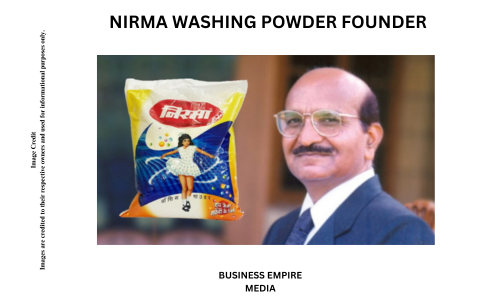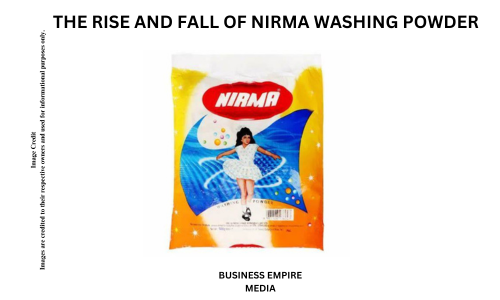In 1969, Karsanbhai Patel launched Nirma Washing Powder from his backyard, setting off a revolution in the Indian detergent market. With its unbeatable price and clever marketing, Nirma quickly went from a small-scale operation to a household name. Patel’s idea was simple but powerful: offer a quality, affordable detergent.
This approach made Nirma a favorite across India. This blog takes you through Nirma’s incredible rise to the top, its peak dominance, and the hurdles it faced that led to its decline, shedding light on how even the most successful brands can be challenged by changing times.
The Rise of Nirma Washing Powder

The rise of Nirma Washing Powder is a story of innovation and disruption. In 1969, Karsanbhai Patel, a chemist from Gujarat, introduced a cost-effective detergent that quickly challenged the established market giants. Priced at just ₹3 per kilogram, Nirma offered the same cleaning power as premium brands but at a fraction of the cost. Patel’s strategic marketing, including the catchy “Washing Powder Nirma” jingle and widespread distribution, made the brand accessible to millions of Indian households.
By the 1980s, Nirma had captured a significant market share and surpassed its competitors, becoming the leading detergent brand in India. This meteoric rise was fueled by Nirma’s unique value proposition and its ability to resonate with the everyday needs of the Indian consumer.
Product Expansion and Market Share

1. Initial Focus and Diversification
- Original Product: Nirma initially entered the market with its washing powder, which quickly gained popularity due to its affordability and effectiveness.
- Diversification Strategy: Recognizing the potential to capture a larger market share, Nirma expanded its product line to include other household items such as soaps, detergent cakes, and even personal care products. This diversification allowed Nirma to cater to a broader range of consumer needs and preferences.
2. Strategic Product Development
- New Product Introductions: Nirma’s expansion into various product categories was not just about adding new items but also about enhancing its existing products. For example, the brand introduced different variants of washing powders and soaps tailored to specific needs, such as enhanced stain removal or special formulations for sensitive skin.
- Innovation and Adaptation: The brand invested in research and development to improve the quality and effectiveness of its products, ensuring they met evolving consumer expectations and stayed competitive in the market.
3. Market Penetration and Reach
- Widespread Availability: Nirma’s strong distribution network was instrumental in its product expansion. The brand ensured that its products were available in both urban and rural areas, making them accessible to a wide audience.
- Retail Presence: Nirma established a robust retail presence, with products available in local kirana stores, supermarkets, and even small shops. This widespread availability helped the brand capture and retain a significant market share.
4. Brand Positioning and Marketing
- Consistent Branding: Throughout its expansion, Nirma maintained a consistent brand image focused on affordability and quality. The iconic “Washing Powder Nirma” jingle and the familiar packaging helped reinforce brand recognition and loyalty.
- Targeted Advertising: Nirma employed targeted advertising campaigns to promote its new products. This included television commercials, print ads, and promotions that highlighted the benefits and affordability of its expanded product line.
5. Competitive Advantage
- Cost Leadership: Nirma’s ability to offer a wide range of products at lower prices than competitors provided a significant competitive advantage. This cost leadership strategy attracted price-sensitive consumers and allowed Nirma to dominate the market.
- Economies of Scale: As Nirma expanded its product line and increased its production volumes, the company benefited from economies of scale. This helped reduce production costs further, enabling the brand to maintain its low pricing strategy.
6. Impact on Market Share
- Increased Market Share: The successful expansion of Nirma’s product line contributed to its dominance in the Indian FMCG sector. By addressing various consumer needs with an extensive range of products, Nirma significantly increased its market share.
- Consumer Loyalty: The brand’s commitment to quality and affordability fostered strong consumer loyalty. As Nirma’s product offerings grew, so did its customer base, leading to sustained market leadership.
7. Long-Term Success
- Sustained Presence: Nirma’s strategic expansion and market penetration efforts ensured its long-term presence in the Indian market. The brand continued to be a major player in the detergent and personal care segments, demonstrating the effectiveness of its growth strategies.
The Fall: The Challenges of Competition and Innovation
Despite its remarkable rise, Nirma faced significant challenges that contributed to its decline in the competitive landscape of the Indian detergent market.
1. Increased Competition
- Entry of Multinational Brands: As Nirma enjoyed its market dominance, multinational giants like Hindustan Unilever (Surf) and Procter & Gamble (Ariel) intensified competition. These companies had substantial resources for marketing and innovation, which began to erode Nirma’s market share.
- Aggressive Marketing: Competitors invested heavily in advertising and promotional activities, positioning their products as superior in terms of quality and performance. This created a more challenging environment for Nirma to maintain its market leadership.
2. Shifting Consumer Preferences
- Rise in Disposable Income: As the Indian economy grew and consumer incomes increased, there was a shift in preferences towards premium products. Consumers began favoring brands that offered enhanced cleaning performance and added features, which often came with a higher price tag.
- Changing Expectations: The evolving market saw a growing demand for innovative and specialized products, such as those with unique formulations or eco-friendly attributes. Nirma’s traditional focus on affordability began to fall out of alignment with these new consumer trends.
3. Lack of Innovation
- Stagnant Product Development: While Nirma had initially set itself apart with its cost-effective solutions, it struggled to keep pace with innovations introduced by competitors. The lack of new product developments or significant improvements to existing products led to perceptions of Nirma as outdated.
- Failure to Adapt: The brand’s reluctance or inability to adapt to changing market dynamics and consumer expectations contributed to its decline. Competitors who introduced advanced products and embraced new technologies gained an edge over Nirma.
4. Operational Challenges
- Complex Distribution Network: As Nirma expanded, managing its extensive distribution network became increasingly complex. Operational inefficiencies and logistical challenges affected the brand’s ability to deliver products consistently and cost-effectively.
- Quality Control Issues: With rapid growth, maintaining consistent product quality and standards became a challenge. Any lapses in quality control further impacted consumer trust and brand reputation.
5. Financial Strain
- Cost Pressures: Despite Nirma’s initial cost leadership, the financial strain of competing with larger, resource-rich competitors took its toll. The brand struggled to balance pricing with the rising costs of production and distribution.
- Investment in Marketing: To compete effectively, Nirma needed to invest more in marketing and brand positioning, which strained its financial resources. The increased expenditure did not always translate into proportional gains in market share.
The story of Nirma offers several key lessons for businesses and entrepreneurs:
- Innovation and Disruption: Nirma’s initial success was driven by its innovative approach to providing a high-quality product at a lower price. This highlights the importance of innovation and finding disruptive solutions to meet consumer needs.
- Effective Branding and Marketing: Nirma’s memorable jingle and strong brand image played a crucial role in its rise. A well-crafted marketing strategy and brand positioning are essential for creating a lasting impact and building consumer loyalty.
- Adapting to Market Changes: The decline of Nirma underscores the need for continuous adaptation and innovation. As consumer preferences and market conditions evolve, businesses must stay agile and responsive to maintain their competitive edge.
- Navigating Competition: Facing increased competition requires a strategic approach. Businesses must be prepared to compete on multiple fronts, including pricing, quality, innovation, and marketing, to sustain their market position.
- Expanding Product Lines: Diversifying product offerings can help capture a larger market share. However, it’s crucial to align new products with evolving consumer demands and ensure they maintain the brand’s core values.
- Managing Growth: Rapid expansion can bring operational challenges. Ensuring efficient operations and maintaining quality control are vital to sustaining growth and meeting consumer expectations.
Conclusion: The Legacy of Nirma
Today, Nirma is no longer the market leader it once was, but its story remains a remarkable example of how a small idea can disrupt an entire industry. Nirma’s rise was a testament to the power of understanding consumer needs and delivering value at an affordable price. Its fall, on the other hand, serves as a reminder of the importance of continuous innovation and adapting to market changes.
While Nirma may not dominate the detergent market anymore, its legacy lives on. The brand paved the way for affordable consumer goods in India and inspired a generation of entrepreneurs. Nirma’s story is a blend of success, challenges, and invaluable lessons for businesses of all sizes.
In the end, Nirma’s journey from a backyard product to a market leader, and then to a brand struggling to keep up with competition, is a powerful narrative of the ever-evolving nature of business. It highlights that in the world of consumer goods, staying relevant is as crucial as achieving success.
